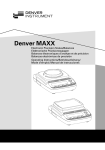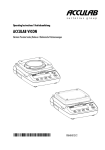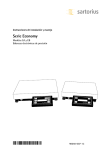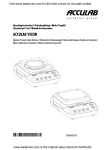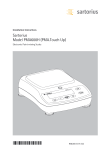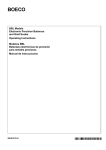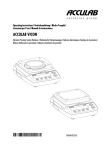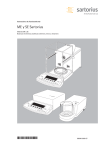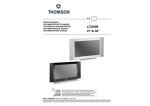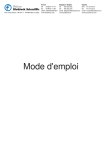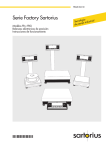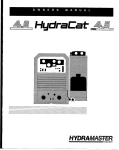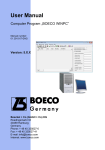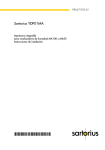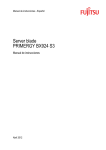Download BEB Series
Transcript
BEB Series Serie BEB Electronic Precision Scales/Balances Balanzas electrónicas de precisión Operating Instructions/Manual de instrucciones 98648-013-84 English page 3 In cases involving questions of interpretation, the German-language version shall prevail. Español página 20 En caso de interpretación, la versión en lengua alemana será determinante. 2 Contents Page Warnings and Safety Precautions 4 Getting Started 5 Operation Basic Weighing Function Description of the Keys 8 8 8 Application Programs Toggling between Weigh Units Counting Weighing in Percent Display Lock Mode Total/Formulation Specific Gravity 9 9 10 11 12 13 14 Calibration/Span Adjustment 15 Advanced Features (Setup Menu) 16 Error Codes 17 Overview Specifications C Marking 18 18 19 3 Warnings and Safety Precautions Safety Information ● To prevent damage to the equipment, please read these operating instructions carefully before using your balance/scale. ! Do not use this equipment in hazardous areas. Installation – It is recommended to connect only BOECO accessories and options, as these are optimally designed for use with your balance/scale. – ! Make sure the voltage rating printed on the power supply is identical to your local line voltage. Symbols The following symbols are used in these instructions: ! Use only commercially available 9 V batteries (not included). If desired, you can use a rechargeable battery. – The balance/scale is energized at all times unless you disconnect the AC adapter and, if connected, the battery. – Protect the AC adapter from contact with liquid ! Exposure to excessive electromagnetic interference can cause the readout value to change. Once the disturbance has ceased, the instrument can be used again in accordance with its intended purpose. 4 Do not open the balance/scale housing as this will void the manufacturer’s warranty. ● indicates steps you must perform $ indicates steps you must perform only under certain conditions > describes what happens after you have performed a certain step – indicates an item in a list ! indicates a hazard Getting Started Equipment Supplied – Balance/scale – Weighing pan – AC adapter Setting Up the Balance/Scale Additional equipment with models BEB53, BEB55: – Calibration weight Additional equipment with model BEB43: – Calibration weight – Round glass draft ring – Level indicator and adjustable feet Installation Choose a location that is not subject to the following negative influences: – Heat (heater or direct sunlight) – Drafts from open windows and doors – Extreme vibrations during weighing – Excessive moisture ● Place the components on the balance/scale in the following order: – Reversible weighing pan – Round glass draft ring on model BEB43 5 Connecting the Balance/Scale to AC Power Installing the Battery (not for model BEB43) ! Use only the AC adapter for optimal performance and safety. Insert plug into the jack (located on back of balance/scale) § Plug the AC adapter into an electrical outlet ! LISTED power supply 11 V–21 V compliant with NEC Class 2 output. § Below-Balance/Under-Scale Weighing $ Batteries are not included with the equipment supplied ! Use only commercially available 9 V batteries. ! If you use a rechargeable battery, recharge it with an external battery charger. § § § A port for a below-balance weighing hanger is located on the bottom of the balance/scale. § Open the cover plate on the bottom of the balance/scale. § Attach the sample (e.g., using a suspension wire) to the hanger. $ Install a shield for protection against drafts if necessary. 6 $ § Lay the balance/scale on its side Open the battery compartment: remove the compartment cover Install the battery in the compartment Make sure the polarity is correct. Close the battery compartment: slide the cover into position until it snaps into place ! Do not throw away used batteries with normal household waste. Rechargeable batteries contain toxic materials and must be disposed of in accordance with local waste disposal regulations. Leveling the Balance/Scale (only for model BEB43) Removing Weights for Calibration/Span Adjustment (not for model BEB61) § Grasp the tab to turn and pull out the weight compartment. § Always wear gloves or use tweezers when handling weights. § Always level the balance/scale again any time after it has been moved to a different location. § Turn the front feet as shown in the diagram until the air bubble is centered within the circle of the level indicator. § Lower all feet to touch the countertop so the balance/scale does not rock. $ Follow instructions on page 15 for calibration/span adjustment. Warmup Time for Model BEB43: To ensure accurate results, the scale must warm up for 1 hour before operation. Only after this time will the scale have reached the required operating temperature. > In most cases this will require several adjustment steps. 7 Operation Basic Weighing Function Description of the Keys Features – Zeroing the balance/scale You can zero the balance/scale within the entire weighing range, up to the maximum capacity. Preparation § Switch on the balance/scale: press the (ON/OFF) key § If necessary, zero the balance/scale: press the (ZERO) key $ If necessary, change the configuration settings: see the chapter entitled “Configuration” $ If desired, reset the factory settings: see the chapter entitled “Advanced Features,” menu item 9.– 1 Additional functions: $ Switching off the balance/scale: press the (ON/OFF) key $ Battery operation: automatic shut-off after 2, 5 or 10 minutes; see chapter on configuration. Example: 2 minutes. If the weight readout remains unchanged and no keys are pressed for at least two minutes, the battery symbol “ “ starts flashing. After another 2 seconds, the balance/scale shuts off automatically, unless a key is pressed. Example: Determine weight of sample Step 1. Switch on the balance/scale Self-test runs Display: Software version (ON/OFF) On/off key: switches the balance/scale on and off or switches it to the standby mode. Battery operation: on; turns backlight on; off (ZERO) Zeros the balance/scale; press and hold 2 seconds: enters application menu (CAL) Starts calibration/adjustment (F) Starts an application program; scrolling in application menu, configuration menu and calibration menu (ENTER) Confirms the selected setting; exits application, configuration & calibration menu if key is pressed and held for at least 2 seconds. (PRINT) Generates a printout or data output Key (or instruction) (ON/OFF) 2. Place container on the balance/scale (in this example, 52 g) 3. Zero the balance/scale 4. Place sample in container on balance/scale (in this example, 150.2 g). 8 Display (ZERO) r 31.01 g 52.0 g 0.0 g 150.2 g Application Programs Toggling between Weigh Units With this application program you can toggle the display of a weight value back and forth between two weigh units (see table below). Example: Toggle weigh unit from pounds [lb] (application) to grams [g] (basic unit) Step Key (or instruction) 1. Select application program (ZERO) ≥ 2 sec 2. Select Toggling between Weigh Units (F) repeatedly 3. Confirm unit of application* (ENTER) 4. Select weigh unit; in this example: “5. Pounds” (see table below) (F) repeatedly 5. Confirm weigh unit (pounds) (ENTER) Display 6. Place sample on balance/scale 7. Toggle weigh unit Menu code 1. user** 2.grams (factory setting) 4.carat 5.Pound 6.ounce 7.tryo 8.tl.hon 9.tl.sin 10.tl.ta 11.grai 12.peny 15.tl.ch 22.pdoz 23.newt * (F) Unit Grams Grams Carats Pounds Ounces Troy ounces Hong Kong taels Singapore taels Taiwanese taels Grains Pennyweights Chinese taels lb/oz Newtons Conversion factor 1.00000000000 1.00000000000 5.00000000000 0.00220462260 0.03527396200 0.03215074700 0.02671725000 0.02645544638 0.02666666000 15.4323583500 0.64301493100 0.02645547175 0.03527396200 0.00980665000 Display o g o lb oz ozt tlk tl tl GN dwt tl lb:oz N Grams is chosen as 1st unit; to changes 1st unit, see Advanced Features section. ** User-defined conversion can be loaded in balance/scale with RS-232 or USB program option. Contact BOECO for more information. 9 Counting Purpose With the Counting program you can determine the number of parts or pieces by weight. Example: Determine the number of uncounted parts; calculate the sample reference quantity (in this example: 20) Step Key (or instruction) 1. Select application program (ZERO) ≥ 2 sec 2. Select Counting (F) repeatedly 3. Confirm application Symbol “ “ on the display: application is active (ENTER) Display 4. Place empty container on the balance/scale 5. Zero the balance/scale (ZERO) 6. Place sample reference quantity (20) on the balance/scale 7. Select sample reference quantity: in increments of 1 (1, 2, 3, ..., 99) or in increments of 10 (10, 20, 30, ...,100) (F) repeatedly (briefly) or (F) ≥ 2 sec. 8. Confirm selected sample reference quantity (ENTER) 9. Place uncounted parts on balance/scale 10. Toggle display between mean piece weight, total weight, and quantity (F) repeatedly 11. Unload the balance/scale 12. Start new Count application or exit application 13. Reactivate Counting (if no other application program has been selected) 14. Repeat procedure starting from Step 5. 10 (ENTER) ≥ 2 sec (F) Weighing in Percent Purpose This application program allows you to obtain weight readouts in percent which are in proportion to a reference weight. Example: Determine an unknown percentage; store the weight on the balance/scale as the reference percentage (100%) Step Key (or instruction) 1. Select application program (ZERO) ≥ 2 sec 2. Select Weighing in Percent (F) repeatedly 3. Confirm application Symbol “ “ on the display: application is active (ENTER) Display 4. Place empty container on the balance/scale 5. Zero the balance/scale (ZERO) 6. Place the reference weight for 100% on the balance/scale 7. If desired, change the number of decimal places displayed: 100.0%, 100.00% or 100% (factory setting) (F) repeatedly 8. Confirm selected no. of decimal places (ENTER) 9. Place unknown weight on the balance/scale 10. Toggle display between weight and percentage (F) repeatedly 11. Unload the balance/scale 12. Start new Weighing in Percent application or exit application (ENTER) ≥ 2 sec 13. Reactivate Weighing in Percent (if no other application program has been selected) (F) 14. Repeat procedure starting from Step 5. 11 Display Lock Mode Purpose The last stable value remains displayed for 5 seconds after removing the sample from the pan. Example: Determine weight of oversized sample Step Key (or instruction) 1. Select application program (ZERO) ≥ 2 sec 2. Select Display Lock (“HLdon”) (F) repeatedly 3. Confirm application Symbol “ ” on the display: application is active (ENTER) 4. If necessary: zero the balance/scale (ZERO) 5. Place sample on balance/scale 6. Start application program (F) Symbol “ ” flashes on the display: when stability conditions are met 7. Unload the balance/scale: the weight value remains displayed for a further 5 seconds; or 8. Zero the balance/scale (ZERO) 9. End the Display Lock application (ENTER) ≥ 2 sec 10. Reactivate Display Lock (if no other application program has been selected) 11. Repeat procedure starting from Step 5. 12 (F) Display Total/Formulation Purpose With this application program you can add successive weight values. The cumulative weight can infinitely exceed the capacity of the balance/scale. Example: Obtaining the total/formulation Step Key (or instruction) 1. Select application program (ZERO) ≥ 2 sec 2. Select Total (formulation) (F) repeatedly 3. Confirm application Symbol “ “ on the display: application is active (ENTER) 4. If necessary: zero the balance/scale (ZERO) Display 5. Place sample on balance/scale (in this example, 380 g) 6. Store value in memory. Total weight is displayed steadily; ∑ symbol flashes. If interface is connected, sample weight is outputted automatically (ENTER) 7. Remove sample or press ZERO 8. Place the next sample on the balance/scale (in this example, 575 g) 9. Store value in memory. Total weight is displayed; along with the flashing ∑ icon. Note: ∑ symbol remains on, indicating stored value in memory until cleared (if interface is connected, sample weight is outputted automatically). (ENTER) 10. To view current individual weight for 2 seconds (if a printer is connected, a printout is generated) (F) 11. Clear Total memory (if a printer is connected, total is printed) (F) ≥ 2 sec 12. Exit Total/Formulation (ENTER) ≥ 2 sec 13. Reactivate Totalizing (if no other application program has been selected) (if a printer is connected, total is printed). (F) 14. Repeat procedure starting from Step 6. 13 Specific Gravity Purpose Use this application program to determine the specific gravity of a sample. The calculation used is Result = Weight in air/(Weight in air – Weight in water). The result is displayed with one decimal place. Beaker and wire not included with balance/scale. Example: Determine the specific gravity of a solid. Step Key (or instruction) 1. Select application program (ZERO) ≥ 2 sec 2. Select Specific Gravity (F) repeatedly 3. Confirm application Symbol “ “ on the display: application is active (ENTER) 4. If necessary, zero the balance/scale (ZERO) 5. Start application program (F) 6. Confirm the display, “airval” (ENTER) 7. Determine weight of the sample in air: place sample on the balance/scale 8. Store weight-in-air value (ENTER) 9. Remove sample from balance/scale 10. Determine weight of sample in liquid: connect wire and set up beaker 11. Confirm the display “Water” (ENTER) 12. Place sample in liquid 13. Store the weight-in-liquid value and view the result (ENTER) 14. Clear the display (ZERO) 15. Exit the Specific Gravity application (ENTER) ≥ 2 sec 16. Reactivate Specific Gravity (if no other application program has been selected) (F) 17. Repeat procedure starting from Step 5. 14 Display Calibration/Span Adjustment Calibration is recommended after initial installation and each time the balance/scale is moved. Features Calibration/adjustment can be performed only when: – there is no load on the balance/scale, – the scale is zeroed, and – the internal signal is stable. If these conditions are not met, an error message is displayed. The weight required for calibration/span adjustment is displayed. Standard calibration weights for selected models: to remove, see instructions on page 7. Press (F) to select a different weight value. To cancel the procedure: press and hold the (ENTER) key (≥ 2 sec.). Example: Calibrate/adjust span of the balance/scale (here: model BEB61) Step Key (or instruction) 1. Switch on the balance/scale (ON/OFF) 2. Zero the balance/scale (ZERO) 3. Start calibration The preset calibration weight is displayed without the weigh unit (in this example, 5000 g) (CAL) 4. To select a different calibration weight value (F) repeatedly 5. Start calibration/span adjustment (ENTER) Display After the zero point is stored, the required calibration weight flashes on the display. 6. Place the required calibration weight on the balance/scale The readout stops flashing if the weight is applied within the defined time limit and tolerance. If the weight value is accepted, the display stops flashing and the stability symbol appears on the display. 7. Remove the calibration weight 8. Calibration/span adjustment has been completed 15 Advanced Features (Setup Menu) Purpose: Serveral advanced balance operations can be changed through menu codes. Select the desired codes from the list below. Then follow the steps to change the menu codes. Step Key (or instruction) 1. 2. (ON/OFF) ZERO 7. 8. Turn balance off. Turn the balance back on. While all segments are displayed, press ZERO key once. Increase the number on display to desired value. Move to the 2nd number of the code. Increase the second number on display to desired value. Move to the 3rd number of the code (when you move to the third number, the previously set menu code will appear). Increase the third number on display to desired value. Confirm new code 9. Exit setup menu. 3. 4. 5. 6. Display MODE ENTER MODE ENTER MODE Hold down the ENTER key until ”0“ appears after the desired code. Press ZERO for more than 2 seconds Special Keyfinctions for Menu Code Operation Key Press briefly Press and hold (F) Increase a number by one with each press (ENTER) Moves to the next of three numbers of a code; hold to confirm setting (ZERO) Moves to the previous number of a codes; hold to exit set-up. ο Factory setting Parameter Settings (Overview) Setup menu 1 Weighing 1.1. Adapt filter 1.1.1 1.1.2 1.1.3 1.1.4 Application filter 1.2.1 1.2.2 ο Final readout 1.3. Stability range 1.3.1 1.3.2 1.3.3 1.3.4 1.3.5 1/4 digit 1/2 digit 1 digit ο 2 digits 4 digits 1.5. Calib./adjust./linearization: Function of the (CAL) key 1.5.1 1.5.2 ο Calibration/span adjustment 1.6. Auto zero 1.6.1 1.6.2 1.7. 1st weigh unit, or 2nd unit in Toggle Weigh Units app. 1.7.1 to 1.7.23 5. and 6. Interface settings; see manual for interface accessory 8. Additional functions 8.1. Block key functions (with battery use only) 8.1.1 8.1.2 8.2. 9. Reset menu Unstable conditions Very unstable conditions 1.2. 1.5.3 16 Very stable conditions ο Stable conditions 9.1. Automatic shut-off (with battery use only) 8.2.1 8.2.2 8.2.3 Factory settings 9.1.1 9.1.2 Filling Linearization: for service personnel only Key blocked ο On Off User-defined unit: see “Toggling between Weigh Units” All keys blocked except for (ON/OFF) and (ZERO) ο All keys unblocked ο After 2 minutes After 5 minutes After 10 minutes Restore ο Do not restore Error Codes Most error codes are shown on the main display for approx. 2 seconds. The program then returns automatically to the previous mode. Display/Problem No segments appear on the display oL UL disErr calErr Cause No power available Solution Check the power supply The AC adapter is not plugged in Battery is drained Plug in the AC adapter Replace battery; recharge battery using external charger Unload the balance/scale The load exceeds the balance/scale capacity Weighing pan not in place Something is touching the weighing pan Display overflow: Value cannot be shown on the display Calibration parameter not met; e.g.: – Balance/scale not zeroed appErr PrtErr Bal.Err Sep.Err Max. weighing capacity is less than indicated under “Specifications” The weight readout is obviously wrong – Balance/scale is loaded Weight is too light or there is no sample on the balance/scale with application in use Data interface for printing is blocked Balance/scale loaded or defective when power was turned on Balance/scale defective The balance/scale was switched on without the weighing pan in place The balance/scale was not calibrated/adjusted before weighing Balance/scale not zeroed Place the weighing pan on the balance/scale Move the object that is touching the weighing pan Reduce load on the balance/scale Calibrate only when zero is displayed Press (ZERO) to tare the balance/scale Unload the balance/scale Increase the weight on the balance/scale Contact the BOECO customer service center Unload balance/scale before switching on or contact BOECO customer service* Contact BOECO customer service Place the weighing pan on the balance/scale and press (ON/OFF) Calibrate/adjust the balance/scale Zero the balance/scale If any other errors occur, contact your local BOECO customer service center * This fault will appear on the display when the unit is powered on. This occurs when the electronics are no longer within the factory set parameters. The most common cause is from objects being dropped onto the weighing pan or from the balance itself being dropped. The balance must be returned for service. 17 Overview Specifications Model Weighing capacity Readability Tare range (subtractive) Linearity Operating temperature range Response time (average) Adaptation to ambient conditions Calibration weight Net weight, approx. Pan size Power source/voltage/frequency Power consumption (average) Hours of operation w/ 9V battery: – Alkaline (approx.) – Rechargeable, fully ch. (NiMH), avg. Model Weighing capacity Readability Tare range (subtractive) Linearity Operating temperature range Response time (average) Adaptation to ambient conditions Calibration weight Net weight, approx. Pan size Power source/voltage/frequency Power consumption (average) Hours of operation w/ 9V battery: – Alkaline (approx.) – Rechargeable, fully ch. (NiMH), avg. * included with the balance 18 W BEB43 BEB53 BEB55 120 610 210 0.001 0.01 0.01 120 610 210 0.003 0.03 0.03 10°C to 30°C (273°K to 303°K; 50°F to 86°F) 2.5 2 2 By selection of 1 of 4 optimized filter levels; display update: 0.1–0.8 sec. (depends on filter level selected) 100* 200* 200* 1.2/2.6 1.35/2.9 1.2/2.6 97/3.8 d 142+130/5.6 + 5.1 97/3.8 d AC adapter, 230 V or 115 V, +15% to – 20%, 48–60 Hz 1 0.75 0.75 h h – – g g g ≤±g s s g kg/lb mm/in 11 2.5 14 4 W BEB61 5000 0.1 5000 0.2 10°C to 30°C (273°K to 303°K; 50°F to 86°F) 2 By selection of 1 of 4 optimized filter levels; display update: 0.1–0.8 sec. (depends on filter level selected) 5* 1.1/2.4 142+130/5.6 + 5.1 AC adapter, 230 V or 115 V, +15% to – 20%, 48–60 Hz 1 h h 11 2.5 g g g ≤±g s s kg kg/lb mm/in C Marking The balance/scale complies with the following EC Directives and European Standards: Council Directive 89/336/EEC “Electromagnetic compatibility (EMC)” Applicable European Standards: Limitation of emissions: In accordance with product standard EN 61326-1 Class B (residential area) Defined immunity to interference: in accordance with product standard EN 61326-1 (minimum test requirements, non-continuous operation) Important Note: The operator shall be responsible for any modifications to BOECO equipment and must check and, if necessary, correct these modifications. 73/23/EEC “Electrical equipment designed for use within certain voltage limits” Applicable European Standards: EN 60950 Safety of information technology equipment including electrical business equipment EN 61010 Safety requirements for electrical equipment for measurement, control and laboratory use Part 1: General requirements If you use electrical equipment in installations and under ambient conditions requiring higher safety standards, you must comply with the provisions as specified in the applicable regulations for installation in your country. On request, BOECO will provide information on the minimum operating specifications (in accordance with the Standards listed above for defined immunity to interference). 19 Contenido Página Contenido 20 Advertencias de seguridad 21 Puesta en marcha Funcionamiento Función básica: Pesar Descripción de teclas 25 25 25 Programas de aplicación Conmutación de unidades Conteo Pesada en porcentaje Lectura estática Totalización Densidad/Peso específico 26 26 27 28 29 30 31 Calibración 32 Ajustes previos (menú Setup) 33 Mensajes de error 34 Sinopsis Especificaciones técnicas Marca C 35 35 36 20 Advertencias de seguridad Seguridad ● Leer con atención este manual de instrucciones antes de poner en marcha el aparato. De esta manera se evitarán daños. ! No usar el aparato en zonas con – Utilizar accesorios y opciones BOECO, que están óptimamente adaptados a la balanza. – No abrir la balanza. Al violarse los sellos (marcas) de seguridad caducan los derechos de garantía. riesgo de explosión. ! El valor de tensión impreso en el alimentador tiene que coincidir con la tensión de red local. ! Usar solamente pila o batería monoblock de 9 V, adquirible en el comercio; el uso de otro tipo de pila/batería puede causar explosión! – La balanza puede ser conectada solamente después de desconectar el alimentador o desactivar la batería, es decir exenta de tensión. – Proteger el alimentador contra la humedad. ! Perturbaciones electromagnéticas extremas pueden influir en la lectura de los valores de peso. Después de eliminarse las perturbaciones, el producto funcionará nuevamente en la forma prevista. 21 Puesta en marcha Suministro – balanza con cubierta protectora transparente – plato de carga redondo o cuadrado – alimentador Instalar la balanza Adicional en BEB53, BEB55: – pesa de calibración Adicional en BEB43: – pesa de calibración – protector contra corrientes de aire – anillo de vidrio – nivel de burbuja y patas de regulación Instalación En la instalación, evitar lugares con las siguientes influencias negativas: – calor (calefacción, rayos solares) – corrientes de aire directas, debido a puertas y ventanas abiertas – vibraciones durante el pesaje – humedad extrema § Montar los siguientes componentes en la balanza: – plato de carga redondo con la cara inferior o superior – Protectores contra corrientes de aire-anillo de vidrio en los modelos: BEB43 22 Conexión a la red Instalar pila/batería (excepto en los modelos BEB43) ! Utilizar solamente alimentador original. § Insertar conector en la parte trasera de balanza § Conectar el alimentador a la red Pesaje por debajo de la balanza $ Pila o batería no forman parte del suministro de la balanza ! Usar solamente pila o batería monoblock de 9 V, adquirible en el comercio. ! Cargar batería solamente con un aparato recargador externo § § § § $ Para los pesajes por debajo de la balanza existe un dispositivo en la base de la balanza. Desatornillar la placa de cierre de la base de la balanza. Colgar la muestra, p. ej. con un alambre, en el gancho. En caso dado, montar protección contra las corrientes de aire. § Voltear la balanza Abrir el compartimento de pila: levantar la cubierta del compartimento Colocar la pila o batería de 9 V $ Observar la polaridad § Cerrar el compartimento de pila: presionar la cubierta del compartimento y encajar ! Pilas o baterías usadas son desechos especiales (no es basura domiciliaria): eliminar las baterías según las prescripciones sobre desechos especiales. 23 Nivelar la balanza (sólo en el modelo BEB43) Sacar las pesas (Excepto en el modelo BEB61) § Girar la tapa del compartimento y jalar $ Proceso de calibración, ver pág. 32 § Nivelar la balanza después de cada cambio del lugar de instalación. § Girar las patas de regulación según la ilustración adjunta, hasta que la burbuja de aire del nivel esté en el centro del círculo. > Por lo general se necesitan algunos pasos más para nivelar. 24 Calentamiento previo para modelo BEB43: Para alcanzar resultados exactos, el aparato necesita un tiempo de calentamiento previo de 1 hora. Hasta entonces alcanza la temperatura necesaria. Funcionamiento Función básica: Pesar Descripción de teclas Características – Tarar la balanza: La tara puede realizarse dentro de todo el rango de pesaje. Preparación § Encender la balanza: pulsar tecla (ON/OFF) § En caso dado, tarar: pulsar tecla (ZERO) $ En caso dado, modificar ajustes de fábrica: ver en el capítulo “Ajustes de fábrica” $ En caso dado, cargar ajustes de fábrica: ver en el capítulo “Ajustes de fábrica”, parámetro 9.– 1 Otras funciones: $ Apagar balanza: pulsar tecla (ON/OFF) $ Funcionamiento en modo batería: apaga autom. después de 2, 5 ó 10 minutos. Si el valor de peso no varía dentro de 2 minutos, mínimo, y si no se pulsa tecla alguna, parpadeará el símbolo de batería « ». Después de transcurrir otros 10 segundos, la balanza se apaga automáticamente. (ON/OFF) (ZERO) (CAL) (F) (ENTER) (PRINT) Encender/apagar: el aparato se enciende, se apaga, o bien pasa al modo Standby Modo batería: encender, retroiluminación, apagar Tarar balanza; mantener pulsada la tecla por 2 segundos: iniciar el menú de aplicaciones Iniciar calibración Iniciar programas de aplicación En el menú de aplicaciones y en calibración: seleccionar parámetros (scroll) Confirmar ajustes de parámetros seleccionados; – aplicaciones – configuración – calibración Finalizar aplicación: mantener pulsada la tecla por 2 segundos Imprimir/salida de datos Ejemplo: determinar el valor de peso Paso Pulsar tecla 1. encender balanza (ON/OFF) se realiza autochequeo Lectura: versión de Software r 31.01 g 52.0 g 2. colocar recipiente para la muestra (aquí, p. ej. 52 g) 3. tarar balanza 4. poner muestra en recipiente (aquí, p. ej. 150,2 g) Lectura (ZERO) 0.0 g 150.2 g 25 Programas de aplicación Conmutación de unidades Con este programa de aplicación puede indicarse el valor de peso en una unidad seleccionada (ver tabla) y en gramos. Ejemplo: conmutar unidad: de libras [lb] (aplicación) a gramos [g] (unidad básica) Paso Pulsar tecla 1 conmutar programa aplicación (ZERO) pulsión larga 2. seleccionar unidad a conmutar (F) 3. confirmar ajuste (ENTER) 4. seleccionar unidad peso; aquí “5. libras” (ver tabla, abajo) repetidam (F) 5. confirmar unidad libras (ENTER) Lectura 6. poner muestra 7. conmutar unidad peso Num. de menú 1. user* 2.grams (ajuste fábrica) 4.carat 5.Pound 6.ounce 7.tryo 8.tl.hon 9.tl.sin 10.tl.ta 11.grai 12.peny 15.tl.ch 22.pdoz 23.newt (F) Unidad Gramos Gramos Quilates Libras Onzas Onzas Troy Taeles Hongkong Taeles Singapur Taeles Taiwan Granos Pennyweights Taeles China lb/oz Newton Conversión 1,00000000000 1,00000000000 5,00000000000 0,00220462260 0,03527396200 0,03215074700 0,02671725000 0,02645544638 0,02666666000 15,4323583500 0,64301493100 0,02645547175 0,03527396200 0,00980665000 * = Unidad definida por el usuario, cargable con progr. PC en la balanza mediante interfaz opcional RS232, o bien USB. 26 Lectura o g o lb oz ozt tl tl tl GN dwt tl lb:oz N Conteo Objetivo Con este programa de aplicación puede determinarse la cantidad de piezas. Ejemplo: determinación de una cantidad desconocida de piezas: pesar cantidad de referencia definida (cantidad de referencia 20) Paso Pulsar tecla 1. conmutar programa aplicación (ZERO) pulsión larga 2. seleccionar Conteo 2x (F) 3. confirmar ajuste símbolo « » en la lectura: aplicación está activa (ENTER) Lectura 4. colocar recipiente en la balanza 5. tarar (ZERO) 6. colocar cantidad referencial (20 piezas) 7. seleccionar cant. referencia: en escalones de uno (1, 2, 3, ..., 99) en escalones de diez (10, 20, 30, ..., 100) repetidam. (F) pulsión breve, o bien mantenerla (F) pulsada 8. confirmar cant. ref. seleccionada (ENTER) 9. poner cant. desconocida de piezas 10. conmutar lectura entre promedio peso de pieza, peso, cant. piezas repetidam. (F) 11. descargar balanza 12. aplicación Conteo: borrar valor ref. 13. reactivar Conteo, si previamente no se ha seleccionado otro progr. aplicación (Enter) pulsión larga (F) 14. en caso dado, seguir desde paso 5. 27 Pesada en porcentaje Objetivo Con este programa de aplicación puede determinarse la proporción porcentual de una muestra, según un peso referencial. Ejemplo: determinar valor porcentaje con: memorizar peso referencial colocando el peso en la balanza, cantidad porcentual de referencia 100 % Paso Pulsar tecla 1. conmutar programa aplicación (ZERO) pulsión larga 2. seleccionar Pesada en porcentaje repetidam. (F) 3. confirmar ajuste símbolo « » en la lectura: aplicación está activa (ENTER) 4. colocar recipiente en la balanza 5. tarar (ZERO) 6. colocar peso referencial para el 100 % 7. en caso dado, modificar decimal para lectura porcentaje: 100,0 %, 100,00 % o bien 100 % (ajuste fábrica) repetidam. (F) 8. confirmar posic. decimal seleccionada (ENTER) 9. poner peso desconocido 10. conmutar lectura entre peso y cantidad porcentaje repetidam. (F) 11. descargar balanza 12. aplicación Pesada porcentaje: borrar cant. porcentaje ref. (Enter) pulsión larga 13. reactivar Pesada en porcentaje, si previamente no se ha seleccionado otro programa de aplicación (F) 14. en caso dado, seguir desde paso 5. 28 Lectura Lectura estática Objetivo Indicar último valor en pantalla cuando se usan cajas u objetos más grandes que el plato de pesada. Ejemplo: determinar muestra sobredimensionada Paso Pulsar tecla 1. conmutar programa aplicación (ZERO) pulsión larga 2. seleccionar «Lectura estática» repetidam. (F) 3. confirmar ajuste símbolo « » en la lectura: aplicación está activa (ENTER) 4. en caso dado, tarar (ZERO) Lectura 5. poner muestra 6. iniciar aplicación (F) símbolo « » parpadea en la lectura: valor peso estable, fijo en la lectura 7. descargar balanza: valor peso estable permanece aún 5 seg. en la lectura 8. o bien, tarar balanza y borrar valor estable indicado (ZERO) 9. finalizar aplicación «Lectura estática» (Enter) pulsión larga 10. reactivar »Lectura estática«, si previamente no se ha seleccionado otro programa de aplicación (F) 11. en caso dado, seguir desde paso 5. 29 Totalización Objetivo: con este programa de aplicación pueden sumarse valores de peso en una memoria aún cuando se rebasa el rango de pesaje de la balanza. Ejemplo: sumar valores de peso Paso Pulsar tecla 1. conmutar programa aplicación (ZERO) pulsión larga 2. seleccionar Totalización repetidam. (F) 3. confirmar ajuste símbolo « » en la lectura: aplicación está activa (ENTER) 4. en caso dado, tarar balanza (ZERO) 5. poner muestra en la balanza (aquí, p. ej. 380 g) 6. guardar valor en memoria; total fijo en la lectura: símbolo parpadea (ENTER) 7. quitar muestra 8. poner siguiente muestra en la balanza (aquí, p. ej. 575 g) 9. guardar valor en memoria; total fijo en la lectura: símbolo parpadea (ENTER) 10. indicar componente actual por 3 seg. (con impresora conectada: impresión simultánea (F) 11. borrar memoria totalización (con impresora conectada: imprimir totalización) (F) pulsión larga 12. finalizar Totalización (Enter) pulsión larga 13. reactivar Totalización, si previamente no se ha seleccionado otro programa aplicación (con impresora conectada: imprimir Totalización). (F) 14. en caso dado, seguir desde paso 6. 30 Lectura Densidad/Peso específico Objetivo: con este programa de aplicación puede determinarse el peso específico de una muestra; el resultado se indica generalmente con una posición decimal. No suministrado: vaso medidor y alambre Ejemplo: determinar el peso específico de una muestra sólida. Paso Pulsar tecla 1. conmutar programa aplicación (ZERO) pulsión larga 2. seleccionar «Peso específico» repetidam. (F) 3. confirmar ajuste símbolo « » en la lectura: aplicación está activa (ENTER) 4. en caso dado, tarar balanza (ZERO) 5. iniciar aplicación (F) 6. confirmar lectura «airval» (ENTER) Lectura 7. determinar peso de muestra en el aire: poner muestra en la balanza 8. memorizar valor peso en aire (ENTER) 9. Quitar muestra 10. determinar valor peso en líquido: poner muestra en el canastillo 11. poner muestra en el líquido 12. confirmar lectura «water» (ENTER) 13. memorizar valor peso en líquido e indicar resultado (ENTER) 14. borrar resultado (ZERO) 15. finalizar aplicación «Peso específico» (ENTER) pulsión larga 16. reactivar «Peso específico», si previamente no se ha seleccionado otro programa de aplicación (F) 17. en caso dado, seguir desde paso 5. 31 Calibración Calibrar la balanza en el lugar, cada vez que se cambie de lugar de instalación. Características El proceso de calibración sólo puede iniciarse, si – la balanza está descargada – la balanza está tarada – la señal interna del peso es estable Si estas condiciones no se cumplen, aparece un mensaje de error. La pesa requerida para la calibración se indica en la pantalla. Pesas de calibr. estándares en los modelos seleccionados, ver en la pág. 24 Otros valores de pesa seleccionables mediante la tecla (F). En caso dado, cancelar proceso de calibración: pulsión larga de la tecla (ENTER) > 2 seg. Ejemplo: calibrar balanza (aquí modelo BEB61) Paso Pulsar tecla 1. en caso dado, encender bal. (ON/OFF) 2. tarar balanza (ZERO) 3. iniciar proceso calibración se indica pesa calibración predefinida, sin unidad (aquí, p. ej. 5000 g) (CAL) 4. en caso dado, seleccionar valor pesa cal. 5. confirmar valor pesa cal. e iniciar calibración después de memorizar el punto cero, se indica la pesa de calibración a aplicar 6. colocar ahora la pesa de calibración finaliza el parpadeo, si la pesa está dentro de los límites predefinidos; después de calibrar, desaparece el símbolo . 7. quitar la pesa de calibración 8. calibración finalizada. 32 repetidam. (F) (ENTER) Lectura Ajustes previos (menú Setup) Configuración de la balanza, es decir, adaptarla a los requerimientos del usuario. Paso Pulsar tecla 1. apagar balanza (ON/OFF) 2. encender balanza y, (ON/OFF) durante la indicación de todos los segmentos Lectura pulsión breve (ZERO) Funciones de teclas en el menú Setup: Tecla Pulsión breve Pulsión larga (ENTER) Nivel menú: mover hacia la derecha; rotando (F) Num. de menú: mover avanzando – (ZERO) Nivel menú: mover hacia la izquierda Memorizar ajuste y abandonar menú Setup ο ajuste fábrica; Ajustes parámetros (sinopsis) Menú Setup 1 Pesar 1.1. Confirmar ajuste Adapt. filtro 1.1.1 1.1.2 1.1.3 1.1.4 ambiente muy tranquilo ο ambiente tranquilo ambiente intranquilo ambiente muy intranquilo 1.2. Filtro aplicación 1.2.1 1.2.2 ο pesar 1.3. Rango estabilidad 1.3.1 1.3.2 1.3.3 1.3.4 1.3.5 1/4 de dígito 1/2 dígito 1 dígito ο 2 dígitos 4 dígitos 1.5. Calibrar/linealizar: función tecla (CAL) 1.5.1 1.5.2 1.5.3 ο calibrar 1.6. Auto-cero 1.6.1 1.6.2 ο activado 1.7. 1. Unidad peso o 2. en aplicación »Conmutar unidad« 1.7.1 seleccionable, ver hasta 1.7.23 en »Conmutar unidad« 5. y 6. Relevante sólo con interfaz datos integrada: ver en descripción de interfaz respectiva 8. Funciones adicionales 8.1. Bloquear func. teclas 8.1.1 8.1.2 8.2. 9. Reset menú √ ajuste usuario 9.1. Apagar bal. autom. Ajuste fábrica 8.2.1 8.2.2 8.2.3 9.1.1 9.1.2 dosificar linealizar: sólo para el servicio tecla bloqueada desactivado todas, excepto (ON/OFF) y (ZERO) ο todas accesibles ο después de 2 minutos después de 5 minutos después de 10 minutos reponer ο no reponer 33 Mensajes de error Mensajes de error aparecen en la lectura principal de pantalla por 2 seg. aprox. A continuación, el programa retorna automáticamente al modo de pesada. Lectura Causa Ayuda/solución No aparecen segmentos de lectura No hay tensión en red Alimentador de CA no está conectado Pila/batería descargadas Controle alimentación de red Conecte alimentador de CA a la tensión de red Recambie pila, recargue batería con aparato externo oL Desborde cap. pesada Quite la carga del plato UL Plato no está colocado Roce entre el plato y su entorno Coloque el plato correctamente Plato de carga no debe rozar piezas adyacentes disErr Desborde de lectura: valor salida en pantalla no es representable Reduzca la carga calErr No se observó condición para calibrar, p. ej.: – puesta a cero – plato aún con carga Quite carga de la balanza Tare con tecla (ZERO) Calibre recién con lectura cero appErr Peso muy liviano, o bien plato sin carga en programas aplicación Aumente el peso PrtErr Interfaz de datos para imprimir, bloqueada Comunique al servicio técnico BOECO Bal.Err Aparato con carga al encender, o bien defectuoso Antes de encender: descargue bal., o bien comunique al servicio técnico BOECO Sep.Err Aparato defectuoso Comunique al servicio técnico BOECO Rango pesaje máx. < lo predefinido en las técnicas Balanza encendida sin plato colocado balanza con tecla (ON/OFF) Coloque el plato Apague y vuelva a encender especif. Resultado de pesada obviamente erróneo Balanza no calibrada No se taró antes de pesar Calibre Tare ¡En caso de aparecer otros mensajes de error, comunicarse con el servicio técnico BOECO! 34 Sinopsis Especificaciones técnicas Modelo BEB43 BEB53 BEB55 Rango de pesada g 120 610 210 Legibilidad g 0,001 0,01 0,01 Rango tara (substract.) g 120 610 210 Desv. Linealidad ≤± g 0,003 0,03 0,03 Rango temp. de uso 10°C – 30°C (273°K – 303°K; 50°F – 86°F) Tiempo estabilización (típico) s 2,5 2 2 Adaptación a las condic. 4 escalas optimizadas de filtro; secuencia de de uso e instalación s lectura: 0,1–0,8 (según escala de filtro ajustada) Valor pesa calibración g 100 (F1) 200 (F2) 200 (M1)) Peso neto aprox. kg 1,2 1,35 1,2 Dimensiones plato carga mm 97 d 142 +130 97 d Conexión, tensión y frecuencia de red vía alimentador 230 V, o bien 115 V, +15%…– 20%, 48–60 Hz Consumo eléctrico (típico) W 1 0,75 0,75 Tiempo funcionam. con – pila monobloque 9 V (alcalina), aprox. h – 11 14 – batería carga compl. (NiMH), típico h – 2,5 4 Modelo Rango de pesada Legibilidad Rango tara (substract.) Desv. linealidad Rango temp. de uso Tiempo estabilización (típico) Adaptación a las condic. de uso e instalación Valor pesa calibración Peso neto aprox. Dimensiones plato carga Conexión, tensión, frecuencia de red Consumo eléctrico (típico) Tiempo funcionam. con – pila monobloque 9 V (alcalina), aprox. – batería carga compl. (NiMH), típico BEB61 5000 00,1 5000 0,2 10°C – 30°C (273°K – 303°K; 50°F – 86°F) s 2 4 escalas optimizadas de filtro; secuencia de s lectura: 0,1–0,8 (según escala ajustada de filtro) kg 5 (F2) kg 1,1 mm 142+130 vía alimentador 230 V, o bien 115 V, +15%…– 20%, 48–60 Hz W 1 g g g ≤± g h h 11 2,5 35 Marca C El aparato cumple los requisitos de las Directivas del Consejo de la Unión Europea: 89/336/CEE »Compatibilidad electromagnética (CEM)« Normas Europeas aplicables: Limitación de las fuentes de distorsión: según norma de producto EN 61326-1 clase B (residencial) BOECO pone a disposición según consultas informaciones sobre la calidad de funcionamiento (según las normas sobre inmunidad definida más arriba mencionadas). 73/23/CEE »Material eléctrico a utilizarse con determinados límites de tensión« Normas Europeas aplicables: Inmunidad definida: según norma de producto EN 61326-1 (requisitos mínimos de control, funcionamiento no continuo) EN 60950 Seguridad de los equipos de tratamiento de la información, incluyendo los equipos eléctricos de oficina Advertencia: Modificaciones en el aparato, así como también la conexión de cables o aparatos no suministrados por BOECO es de responsabilidad del usuario y deben ser controladas por él mismo, y en caso dado corregidas. EN61010 Requisitos de seguridad de equipos eléctricos de medida, control y uso en laboratorio Parte 1: Requisitos generales 36 Al utilizarse equipo eléctrico en instalaciones, bajo condiciones ambientales que requieren altas medidas de seguridad, han de observarse las prescripciones correspondientes para la instalación. Boeckel & Co. Roedingsmarkt 33 20459 Hamburg, Germany t +49 (0) 40-3256270 f +49 (0) 40-32562741 E-mail: [email protected] 98648-013-84 Publication No.: WXX6072-al05101 W1A000.BOECO BEB








































